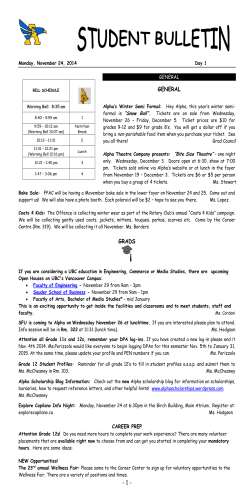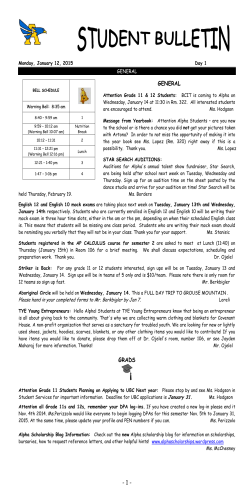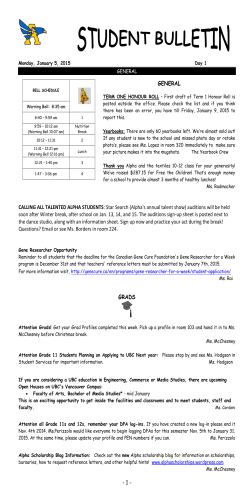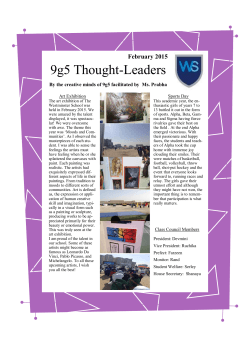
Z235.`
Feb. 3, 19.70‘ ‘J. H. DAVIES ET AL 3,493,751 TRACK REGISTRATION ALPHA AUTIORADIOGRAPHY Filed June 17, 1966 Z235.‘ United States Patent 0’ "ice 2 1 available chemicals in daylight. The method is inexpen sive and simple to execute, and does not require special 3,493,751 ?xtures or skilled personnel. TRACK REGISTRATION ALPHA ‘Our method is based on a known process which is usu AUTORADIOGRAPHY ally called “track etching”. The track-etching process em ploys a homogeneous, solid-state detector material which John H. Davies, Danville, Carl P. Ruiz, Fremont, and Howard A. Storms, Livermore, Calif., assignors to Gen eral Electric Company, New York, N.Y., a corporation may be a crystalline solid such as mica, or a non-crystal line substance such as inorganic glass or a polymeric of New York Filed June 17, 1966, Ser. No. 558,490 Int. Cl. G01t 3/00, 5/00; H01j 39/32 7 US. Cl. 250-83 3,493,751 Patented Feb. 3, 1970 plastic. The detector material is irradiated by charged particles, and damage tracks are created in the material Claims by local alteration of the material structure along the particle trajectories. The damage tracks are then enlarged and made visible by application of a reagent which pref erentially attacks the altered material along the damage ABSTRACT OF THE DISCLOSURE A process for producing autoradiographs of alpha track at a faster rate than it attacks the undamaged ma particle emitting objects is disclosed. Typically, a sheet of 15 terial around the track. A description of the track-etching track-registration material is placed adjacent an object having alpha-particle emitting portions, maintained there process appears at page A1443 of “Physical Review” vol ume 133, number 5A (March 1964). for suitable period and then treated with an etchant. The ' We have found that certain electrically insulating, etchant selectively dissolves damage tracks along parts homogeneous detector materials such as cellulose plastics traversed in the material by alpha particles. The tracks 20 register damage tracks when subjected to alpha radiation, produce a visible image corresponding to alpha-emitting but do not register beta- and gamma-radiation damage portions of the objects. tracks. This damage-track selective sensitivity is exploited in the formation of alpha autoradiographs of an object An autoradiograph is an image or record of radioactive 25 which emits alpha particles, and which may also exhibit material in an object, and is typically made by position ing a sheet of photographic ?lm against the object. Vari beta and gamma radiation. A damage-track response in these materials occurs only along the trajectories of alpha particles, and subsequent chemical processing of the latent image created by the damage tracks makes visible tive emulsion on the ?lm to form a latent image of 30 an image of the alpha-radiating portions of the object radioactive areas of the object. The ?lm is then chemically under examination. developed to make visible the latent image. This process This method of forming an alpha autoradiograph is is generally similar to the technique of producing a con especially useful in the examination of irradiated ‘fuel ventional X-ray radiograph, except that the autoradio~ materials from nuclear reactors. While beta-gamma auto ous types of radiation from the object penetrate a sensi graphic object itself is the source of radiation, and a 35 radiographs are also useful in this application, an alpha separate source of radiation is unnecessary. The resulting autoradiograph yields additional uniquely valuable infor autoradiograph is useful in detecting and mapping the mation on the distribution of alpha-emitting materials presence of areas in the object which are radioactive. such as plutonium in the fuel. Beta-gamma autoradio Photographic ?lms adapted for radiography have sev graphs yield information on the distribution of beta-gam eral drawbacks which have limited and complicated the 40 ma emitting ?ssion products in the fuel. making and use of autoradiographs, and especially alpha Brie?y stated, the invention is a process for making an particle autoradiographs. Such ?lms are normally light sensitive, and precautions must be taken to protect the autoradiograph of an object having portions which emit alpha particles. A substantially homogeneous, electrically ?lm from exposure to light prior to completion of chemi insulating track-registration material is placed adjacent the cal development and ?xing or stabilization. Darkroom 45 alpha-emitting object, and preferably in face-to-face con facilities and personnel are thus typically required for tact With the object. The material has the quality of being ?lm processing, and the ?lm must be packaged and han substantially insensitive to light, and further has a selec dled in a light-tight enclosure prior to processing. tive-sensitivity property of forming damage tracks only Another problem with photographic ?lm in certain applications is that it is non-selectively sensitive to many 50 along paths in the material traversed by alpha particles when the material is irradiated by alpha, beta and gamma different kinds of energetic particles and electromagnetic radiation. After exposure of the material to the alpha radiation. Most ?lms are directly sensitive to alpha and emitting object, the material is etched with a chemical beta particles, and are also affected by neutrons, X-ray reagent which selectively attacks and enlarges the damage and gamma radiation, and the like, as photoelectrons and recoil protons which form track images are produced in 55 tracks. This etching forms craters or pits in thesurface of the material wherever damage tracks are present, and the the sensitive emulsion of the ?lm by this kind of bom damage tracks are thereby made visible to form an auto— bardment. radiographic image of the alpha-emitting portions of the The lack of selective sensitivity of photograph ?lm object. limits the production of autoradiographs which are sensi tive to alpha particles and insensitive to beta particles, 60 The material is washed after etching to remove the re agent, and the resulting autoradiograph is ready for im gamma rays, and the like. In some applications, the ex mediate inspection. Alternatively, the autoradiograph may posure resulting from non-alpha radiation may com pletely mask the alpha tracks, preventing detection and accurate mapping of an alpha-emitting source in the object. The method of this invention overcomes these prob lems of conventional photographic ?lm, and makes possi ble the generation of an autoradiograph which is sub stantially sensitive to alpha radiation alone; i.e., an alpha autoradiograph. Light shielding and darkroom processing is unnecessary, and the latent autoradiographic image is “developed” or made visible by processing with readily be used as a photographic negative from which a positive print is made using conventional photographic techniques. 65 The pits or craters on the material form darkened areas which print as light areas in'the photographic positive. In a presently preferred form of the process, a sheet of cellulose nitrate is used as the track-registration material. Sodium hydroxide is a suitable reagent for selective attack 70 of the damage material along the damage tracks. The invention will be discussed in detail in terms of its application to autoradiographic examination of fuel pel 3 3,493,751 4 lets from a nuclear reactor, and with reference to the at although they can be detected through careful use of an tached drawings, in which: FIG. 1 is a perspective view of a portion of fuel pel electron microscope. let; exposed track-registration sheet of cellulose nitrate to en large the individual damage tracks. We have found that a six-normal aqueous solution of sodium hydroxide at ap proximately 60° Centigrade is a satisfactory etching re An etching reagent is then applied to face 16 of the FIG. 2 is a perspective view of a sheet of track-registra tion material positioned against an end face of the fuel ellet; p FIG. 3 is a plan view of a face of the track-registration material which was in contact with the fuel pellet, with agent, and provides satisfactory de?nition of the damage tracks in an etching period in the range of one to ten invisible damage tracks identi?ed by light stippling; minutes. Damage-track pit or crater diameiers between about two and ?ve microns are convenient for subsequent projection or optical examination, and such tracks or craters are typically produced in an etching period of four FIG. 4 is an enlarged side view of a portion of the ma terial shown in FIG. 3; FIG. 5 is a plan view of the track-registration material after etching, with enlarged damage pits or craters being indicated by dark stippling; FIG. 6 is an enlarged side view of a portion of the ma terial shown in FIG. 5; and FIG. 7 is a plan view of a positive photographic print made by using the material shown in FIGS. 5 and 6 as a photographic negative. Referring to the drawings, FIG. 1 shows a fuel pellet 10 of generally cylindrical form, and having a hollow, cy lindrical outer casing or cladding 11 which surrrounds a fuel element 12. Such fuel pellets are commonly used in to six minutes. 15 The etching rate can be adjusted by changing the tem perature or the concentration of the etching reagent. The exact etching time is generally not critical, and need only be sufficient to produce sufficient damage-track enlarge ment that the resulting pits or craters are visible in good contrast when the sheet is viewed by transmitted light. Excessive enlargement from extended etching of the pits or craters is undesirable in most applications due to the resulting loss in image resolution and contrast. The rea gent is removed at the end of the etching step by rinsing nuclear reactors, and a typical fuel element may include a 25 the track-registration sheet in water. blend of plutonium and uranium compounds. The fuel FIGS. 5 and 6 show individual pits or craters 21 after pellet has been cut across its longitudinal axis and polished completion of the etching and rinsing steps. The craters to expose a smooth end face of the cladding and fuel are shown in a ‘fairly dense, relatively uniform pattern around the periphery of the fuel-element image, and grad element for radiographic examination. In FIG. 2, a track-registration material such as a sheet 30 ually shading off to lower densities as the center of the typically performed using conventional remote-handling image is approached. Several isolated clusters of etched damage tracks also appear in the central area of the image. The processed track-registration material or auto pass into the material from the fuel element. These mate— light, the etched pits or craters appear as dark circular 15 of cellulose nitrate is placed in face-to-face contact with the end face of fuel pellet 10. The positioning step is radiograph thus indicates that alpha-emitting plutonium apparatus (not shown) to avoid exposure of personnel to in the fuel element has tended to form in radially outer radioactivity. In some applications, it may be desirable to portions of the fuel element, with a few isolated frag interpose a very thin (i.e., having a thickness less than ments appearing in the central portion of the element. the penetration range of alpha particles from the pellet) Non~homogeneity of the fuel blend or of plutonium for plastic absorber (not shown) between the end face of the fuel pellet and sheet 15 to prevent adherence of radioac 40 mation is thus immediately detected, and the high resolu tion provided by the short-range alpha particles provides a tive particles from the pellet on the sheet. precise picture of fuel-element composition, distribution A face 16 of the cellulose-nitrate sheet is thus bombard and ?ne structure. ed by alpha particles emitted by the plutonium in the fuel The processed track-registration material or autoradio element, and is also irradiated by beta and gamma radia graph may be used directly for visual examination, or tion from the fuel element. Cellulose nitrate and other cellulose-ester materials have the property of forming 45 may be used as a photographic “negative” from which a positive print is prepared. When viewed with transmitted damage tracks along the paths of alpha particles which rials, however do not form damage tracks from beta and gamma radiation. or cone-shaped areas in high contrast with the background of relatively transparent, undamaged material. The auto Massive doses of beta-gamma radiation may degrade 50 radiograph is thus very suitable as a photographic nega tive, and excellent enlargements are obtained by printing these plastics to the extent that they become somewhat on a relatively high contrast printing paper of any conven brittle and more soluble in an eching reagent. However, tional type. A short exposure time with overdevelopment individual beta-gamma damage tracks are not registered, will further improve the contrast in the positive print of and the effect of this type of radiation does not mask the registration of damage tracks formed by impinging alpha 55 the damaged areas to the undamaged background material. A positive print 24 is shown in FIG. 7, and has a dark particles. outer annular ring corresponding to the cladding on the Alpha-particle damage tracks 19 are illustrated sche fuel element. The portion of the track-registration mate matically by stippling and dashed lines in FIGS. 3 and 4. rial or autoradiograph which was in face-to-face contact The damage tracks are very small, and are invisible to with the cladding remains essentially clear after etching 60 the naked eye or to an optical microscope. Thus, the dam as no damage tracks are formed in that area. The positive age-track stippling and dashed lines in FIGS. 3 and 4 are print is therefore black in those areas where no damage by way of explanation only and are not intended to show tracks exist in the autoradiograph “negative.” Light areas in the positive print, indicated schematically as regions 25 in FIG. 7, represent areas of high alpha radiation in the 3 and 5 is shown for orientation only, and no damage 65 fuel pellet, as these regions are images of high-density pit tracks will appear in the track-registration material which or crater areas on the autoradiograph. was positioned against the cladding unless the cladding Thickness of the sheet of track-registration material is is emitting alpha particles. not critical, and can be selected to register damage tracks A typical alpha particle having an energy of say 4.5 which extend only part way into the sheet (to form sur mev. will penetrate the track-registration material to a 70 face pits or craters after etching) or which extend entirely the actual appearance of the “exposed” track-registration material. The phantom outline of cladding 11 in FIGS. depth of perhaps forty microns, and the resulting damage track will have a width in the range of about twenty to one hundred angstroms. It ‘will be appreciated that these tracks are too small to be Seen with an ordinary microscope, through the sheet (to form holes through the sheet after etching). As mentioned above, the range of alpha particles in these materials is quite short (typically about forty microns), and the sheet must therefore be very thin if 3,493,751 5 6 whereby the damage tracks are made visible to form through holes are to be formed. For most applications, a fairly thick sheet of say 0.0l0-inch thickness is preferred to provide suf?cient stiffness for convenient handling by an autoradiographic image of the alpha-particle emitting portions of the object. 2. The process de?ned in claim 1 in which the track registration material is a cellulose ester. 3. The process de?ned in claim 1 in which the track registration material is selected from the group consisting of cellulose nitrate, cellulose acetate, and cellulose acetate mechanical manipulators. Both pits and holes provide very ' satisfactory images, thick sheets with pits providing some what ‘better contrast, and thin sheets with holes providing somewhat better resolution. Materials other than cellulose nitrate are suitable for butyrate. the track-registration material, and various cellulose esters 4. A process for making an autoradiograph of an object have been investigated and found suitable. For example, 10 having portions which emit alpha particles, comprising sheets of cellulose acetate and acetate-butyrate form dam the steps of: age tracks in response to alpha-particle radiation. Cellu~ (a) positioning a sheet of cellulose nitrate adjacent the lose nitrate, however, is preferred as it exhibits the highest object, whereby damage tracks are formed along paths sensitivity to damage-track formation for a given level of in the sheet traversed by alpha particles from the alpha-particle radiation. object; While sodium hydroxide is a preferred etching reagent, (b) maintaining said sheet in position for a period suf other reagents which chemically etch (rather than dis ?cient to permit portions of the sheet surface to be solve) the track-registration material can be used. For penetrated by from about 105 to about 1011 alpha example, potassium hydroxide, ammonium hydroxide, particles per square centimeter; and and sodium and potassium carbonates produce the desired 20 (c) etching the sheet of cellulose nitrate with a chem etching effect. Etching time is typically a function of rea gent temperature, and may vary from say 30‘ seconds at 70° C. to several hours at room perature. Image quality in the ?nished autoradiograph is a func ical reagent which selectively attacks and enlarges the damage tracks whereby the damage tracks are made visible to form an autoradiographic image of the alpha-particle-emitting portions of the object. tion of “exposure”; i.e., the intensity of the radioactive 5. The process de?ned in claim 4 in which the chemical source and the duration of contact between the object and the track-registration material. Good images are obtained with a damage-track density of about 108 or 109 tracks per ' square centimeter. Preferably, the damage-track density reagent is sodium hydroxide. 6. The process de?ned in claim 5 in which the sheet of cellulose nitrate is etched with an approximately six in heavily exposed regions of the image should be held in 30 normal aqueous solution of sodium hydroxide for a period in the range of about one to about ten minutes. the range of about 105 to about 1011 tracks per square 7. A process for making an autoradiograph of an ob centimeter. ject having portions which emit alpha particles, comprising While our method has been described in terms of its the steps of: application to examination of an atomic-reactor fuel (a) positioning a sheet of cellulose nitrate adjacent the pellet, it is to be understood that this is only one of many object, whereby damage tracks are formed along the possible uses for the invention. The invention has utility paths in the sheet traversed by alpha particles from in many areas of non-destructive testing where it is de the object; sirable to determine the presence and distribution of alpha-particle-emitting substances in an object. The proc 40 ess is useful with any object which emits alpha particles, and is especially useful where it is desirable to register alpha emission selectively without registration of beta or gamma radiation from the same object. The above-de (b) maintaining said sheet in position for a period suf ?cent to permit portions of the sheet surface to be penetrated by from about 105 to about 1011 alpha particles per square centimeter; (c) etching the sheet of cellulose nitrate with a chem ical reagent which selectively attacks and enlarges the damage tracks whereby the damage tracks are made visible to form an autoradiographic image of scribed track-registration materials and etching chemicals are inexpensive and readily available, and the process can be carried out by inexperienced personnel. The materials are insensitive to light (in comparison to photographic the alpha-particle-emitting portions of the object; (d) removing the reagent from the sheet of cellulose nitrate; and (e) forming a photographic print of the autoradio graphic image by using the etched sheet of cellulose emulsions which have been in common use in the past), eliminating the need for darkroom techniques and light tight packaging. What is claimed is: 1. A process for making an autoradiograph of an object nitrate as a photographic negative. having portions which emit alpha particles, comprising the References Cited steps of: UNITED STATES PATENTS (a) positioning a substantially homogeneous, electri cally insulating track-registration material adjacent the object, the material being substantially insensitive to light and having a selective-sensitivity property of forming damage tracks only along paths in the ma terial traversed ‘by alpha particles when irradiated by alpha, beta and gamma radiation; (b) maintaining said material in position for a period su?‘icient to permit portions of the surface of the ma terial to be penetrated by from about 105 to about 1011 alpha particles per square centimeter; and (c) etching the material with a chemical reagent which selectively attacks and enlarges the damage tracks 60 2,733,353 3,282,756 3,335,278 1/1956 Pirson ____________ __ 250-65 11/ 1966 Hawley __________ __ 250--65 X 8/1967 Price et al. _______ __ 250-—-83.1 OTHER REFERENCES Tracks of Charged Particles In Solids, by Fleischer et al, from SCIENCE, vol. 149, No. 3682, July 23, 1965, _ pgs. 3834393. ARCHIE S. BORCHELT, Primary Examiner U.S. Cl. X.R. 250-65, 831
© Copyright 2024









